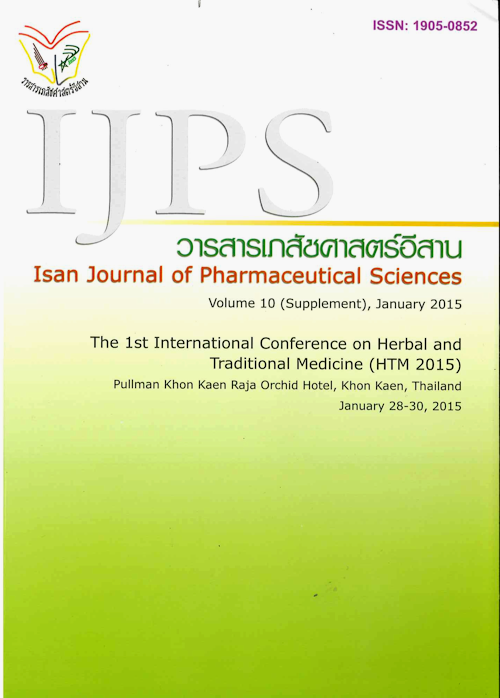Development of Deformable Liposomes for Transdermal Delivery of Extraction from Chili Pepper
Main Article Content
Abstract
Introduction: Capsaicin is a main pungent ingredient in chili peppers. It can stimulate the
release of vasoactive neuropeptides (substance P) and calcitonin gene-related peptide (CGRP) from
C-fi ber nerve ending. Thus capsaicin is used as a medication for the temporary relief of neuralgia,
rheumatism, lumbago and sciatica. However, it has been reported that the strong pungency, the short
half-life and the poor water solubility of capsaicin lead to its limitation in the development of capsaicin
formulations as pharmaceutical products. To achieve this aim, deformable liposome formulation with
novel non-ionic surfactant was developed. Methods: The liposomes containing a constant amount of
0.15% capsaicin, phosphatidylcholine, cholesterol and non-ionic surfactant (e.g., Comperlan® KD and
Tween® 20) were prepared. Conventional liposomes (CLP) and three deformable liposomes (DLP)
were evaluated for physical properties (e.g. size, size distribution, zeta potential), drug content and
skin permeability. Results: The results revealed that the liposome formulations containing 0.15%
capsaicin were smaller than 100 nm in size, narrow size distribution (0.01-0.20) and had negative zeta
potential value (less than -10 mV). The skin permeability of the deformable liposomes composed of
Comperlan® KD and Tween® 20 was signifi cantly higher than CLP and commercial product (control).
Moreover, the application of deformable liposomes signifi cantly disrupted the microstructure of the
stratum corneum. Conclusion: The novel deformable liposome composed of the combination of
non-ionic surfactants was successfully developed as a transdermal delivery carrier for chili pepper
extract.
Article Details
In the case that some parts are used by others The author must Confirm that obtaining permission to use some of the original authors. And must attach evidence That the permission has been included
References
Bae D-H, Shin J-S, Jin F-L, Shin G-S, Park S-J. Effect of Hydrogenated Lecithin on Cytotoxicity of Liposome. BKCS. 2009; 30(2): 339-342.
Cevc G, Blume G. Lipid vesicles penetrate into intact skin owing to the transdermal osmotic gradients and hydration force. BBA. 1992; 1104(1): 226-232.
Duangjit S, Opanasopit P, Rojanarata T, Ngawhirunpat T. Characterization and in vitro skin permeation of meloxicam-loaded liposomes versus transfersomre. J Drug Deliv. 2010; 2012, Article ID 418316, 9 pages, doi:10.1155/2011/ 418316.
Duangjit S, Opanasopit P, Rojanarat T, Ngawhirun-pat T. Evaluation of meloxicam-loaded cationic transfersomes as transdermal drug delivery carriers. AAPS Pharm-SciTech. 2013; 14: 133-140.
Elsayed M, Abdallah O, Naggar V, Khalafallah N. Deformable liposomes and ethosomes: mechanism of enhanced skin delivery. Int J Pharm. 2006; 322: 60-66.
Fang Y-P, Tsai Y-H, Wu P-C, Huang Y-B. Comparison of 5-aminolevulinic acid-encap-sulated liposome versus ethosome for skin delivery for photodynamic therapy. Int J Pharm. 2008; 356(1–2): 144-152.
Fraenkel L, Bogardus Jr ST, Concato J, Wittink DR. Treatment options in knee osteoarthritis: the patient’s perspective. Arch Intern Med 2004; 164(12): 1299-1304.
Huang YB, Lin YH, Lu TM, Wang RJ, Tsai YH, Wu PC. Transdermal delivery of capsaicin derivative-sodium nonivamide acetate using microemulsions as vehicles. Int J Pharm. 2008; 349(1–2): 206-211.
Knotkova H, Pappagallo M, Szallasi A. Capsaicin (TRPV1 agonist) therapy for pain relief: farewell or revival? Clin J Pain. 2008; 24: 142–154.
Kumar GP, Rajeshwarrao P. Nonionic surfactant vesicular systems for effective drug de-livery—an overview. Acta Pharm Sin B. 2011; 1(4): 208-219.
Luo X-J, Peng J, Li Y-J. Recent advances in the study on capsaicinoids and capsinoids. Eur J Pharmacol. 2011; 650: 1–7.


